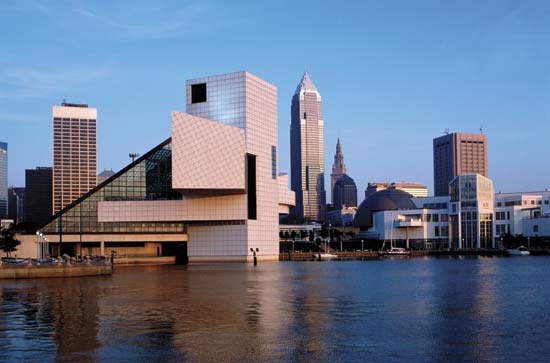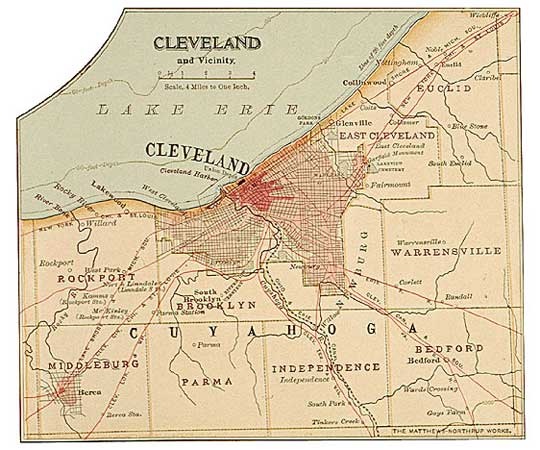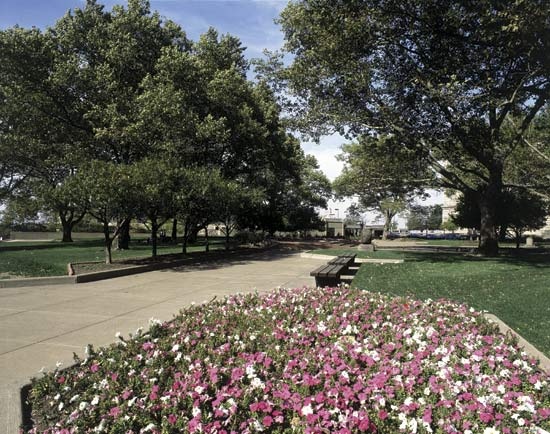Cleveland
Ohio, United States
Introduction
 city, seat (1810) of Cuyahoga county, northeastern Ohio, U.S. It is a major St. Lawrence Seaway (Saint Lawrence River and Seaway) port on the southern shore of Lake Erie (Erie, Lake), at the mouth of the Cuyahoga River. Greater Cleveland sprawls along the lake for about 100 miles (160 km) and runs more than 40 miles (65 km) inland, encompassing Cuyahoga, Lake, Geauga, and Medina counties and more than 70 suburban communities, including Lakewood, Parma, Shaker Heights, Cleveland Heights, East Cleveland, Euclid, Garfield Heights, and Rocky River.
city, seat (1810) of Cuyahoga county, northeastern Ohio, U.S. It is a major St. Lawrence Seaway (Saint Lawrence River and Seaway) port on the southern shore of Lake Erie (Erie, Lake), at the mouth of the Cuyahoga River. Greater Cleveland sprawls along the lake for about 100 miles (160 km) and runs more than 40 miles (65 km) inland, encompassing Cuyahoga, Lake, Geauga, and Medina counties and more than 70 suburban communities, including Lakewood, Parma, Shaker Heights, Cleveland Heights, East Cleveland, Euclid, Garfield Heights, and Rocky River.Most of the city lies on a plain that rises 60 to 80 feet (18 to 25 metres) above the lake and is divided by the narrow valley of the Cuyahoga, locally known as the Flats. Lake Erie moderates the city's climate, keeping temperatures generally cooler in summer and warmer in winter and occasionally causing heavy "lake effect" winter snows. Inc. city, 1836. Area city, 82 square miles (212 square km). Pop. (2000) city, 478,403; Cleveland-Elyria-Mentor MSA, 2,148,143; (2006 est.) city, 444,313; Cleveland-Elyria-Mentor MSA, 2,114,155.
History
Erie Indians in the region were driven out by the Iroquois in the 17th century. The French established a trading post in the vicinity in the mid-18th century. In 1786, three years after the American Revolution, when the Ohio country was opened for settlement, Connecticut laid claim to a vast area of land (the Western Reserve) in northeastern Ohio. Moses Cleaveland, from the Connecticut Land Company, arrived with surveyors at the mouth of the Cuyahoga in July 1796 to map the area. He founded and laid out the town of Cleaveland. (In 1832 an a in Cleaveland was dropped to shorten a newspaper's masthead.)
 The city's growth was slow until 1832, when the Ohio and Erie Canal (begun in 1825 to connect Lake Erie (Erie, Lake) and the Ohio River) was completed. In the 1850s railroads increased the community's commercial and industrial activity. When St. Marys Falls Canal (Soo Canal) between Lakes Superior and Huron was opened in 1855, Cleveland became Lake Erie's transshipment point for lumber, copper and iron ore, and rail shipments of coal and farm produce. The American Civil War provided the initial stimulus for iron and steel processing, metals fabrication, oil refining (John D. Rockefeller (Rockefeller, John D.) founded Standard Oil there), and chemical manufacturing. Suburban trains were developed at the end of the 19th century. By the 1930s Cleveland had the appearance of a modern metropolis, with main roads converging on its Public Square, which was dominated by the 708-foot (216-metre) Terminal Tower. Rapid-transit lines now extend to Shaker Heights and East Cleveland (east) and to the Cleveland Hopkins International Airport (southwest).
The city's growth was slow until 1832, when the Ohio and Erie Canal (begun in 1825 to connect Lake Erie (Erie, Lake) and the Ohio River) was completed. In the 1850s railroads increased the community's commercial and industrial activity. When St. Marys Falls Canal (Soo Canal) between Lakes Superior and Huron was opened in 1855, Cleveland became Lake Erie's transshipment point for lumber, copper and iron ore, and rail shipments of coal and farm produce. The American Civil War provided the initial stimulus for iron and steel processing, metals fabrication, oil refining (John D. Rockefeller (Rockefeller, John D.) founded Standard Oil there), and chemical manufacturing. Suburban trains were developed at the end of the 19th century. By the 1930s Cleveland had the appearance of a modern metropolis, with main roads converging on its Public Square, which was dominated by the 708-foot (216-metre) Terminal Tower. Rapid-transit lines now extend to Shaker Heights and East Cleveland (east) and to the Cleveland Hopkins International Airport (southwest).Cleveland's economy, hard hit by the Great Depression of the 1930s, experienced renewed growth during World War II. However, the city's industrial mainstays subsequently declined, a decline matched by a precipitous drop in population; in 2000 Cleveland's population was only about half of what it had been in the peak year of 1950, when it reached 915,000. Tens of thousands (mainly those of European ancestry) moved to the suburbs, but many others left the area as jobs disappeared. Economic hardship especially affected the city's large and less-mobile African American community, which by 2000 constituted more than half of the city's population. In 1966 Cleveland's Hough district was the scene of violent racial disorders. Municipal government faced mounting budgetary problems, capped by default on bank loans in the late 1970s. In addition, environmental pollution became severe, a condition infamously highlighted by a June 1969 fire on the Cuyahoga River caused by floating chemical wastes.
In 1967 Carl Stokes (Stokes, Carl) was elected mayor of Cleveland, the first African American to win such office in a major U.S. city. Under Stokes and his successors (white and black), the city undertook a long revitalization process. Beginning in the 1960s, much of the downtown area was rebuilt, and since the 1980s steps have been taken to improve the city's environment. Notable effort has been directed at cleaning up the Cuyahoga. The downtown skyline, long dominated by Terminal Tower (1930), was dramatically altered by the addition of BP Tower (1985) and the 63-story Key Tower (1991), at the time of its completion the tallest building between New York City and Chicago.
The contemporary city
Heavy industry remains important to the city's economy. Manufactures are highly diversified and include primary steel, steel products, motor vehicles, automotive parts, medical products, greeting cards, processed foods, chemicals, and electronic equipment. Services (including health care, banking and finance, insurance, and government) account for the major proportion of the economy. Cleveland's port is one of the largest on the Great Lakes, and the city has extensive rail and highway connections. Scores of medical and industrial research centres are headquartered in the area, including the National Aeronautics and Space Administration's John H. Glenn Research Center and the Cleveland Clinic, renowned for cardiac care.
University Circle, with Case Western Reserve University (1967; a federation of Case Institute of Technology 【1880】 and Western Reserve University 【1826】) as its locus, is the city's cultural centre. Among its more than 35 medical, educational, cultural, and religious institutions are the Cleveland Institute of Art (1882), the Cleveland Institute of Music (1920), the Cleveland Museum of Art, Severance Hall (home of the Cleveland Orchestra), the Western Reserve Historical Society, the Cleveland Museum of Natural History, HealthSpace Cleveland, and Cleveland Botanical Garden. Other educational institutions in the city include Cuyahoga Community College (1963) and Cleveland State University (1964). Suburban schools include three Roman Catholic institutions— John Carroll University (1886) in University Heights, Notre Dame College (1923) in South Euclid, and Ursuline College (1871) in Pepper Pike—and Baldwin-Wallace College (1845) in Berea.
City, county, and federal office buildings, the Cleveland Public Library (with one of the largest holdings of any city library in the country), and the Cleveland Convention Center are downtown, near the lakefront. Lakeside attractions include the Rock and Roll Hall of Fame and Museum (1995), designed by architect I.M. Pei (Pei, I.M.) and one of the city's major tourist attractions; the Great Lakes Science Center, which opened in 1996; and Cleveland Browns Stadium (1999), home of the Browns (Cleveland Browns), the city's professional gridiron football team. The southern downtown area includes the Gateway Complex, comprising two sports venues that opened in 1994: Jacobs Field, which is built in the style of early 20th-century ballparks, for the Cleveland Indians professional baseball team; and Gund Arena, home of the Cavaliers professional basketball team. Playhouse Square Center, southeast of downtown, contains several historic theatres and is home to the Great Lakes Theater Festival, the Cleveland Opera, and the Ohio Ballet. The centre of Cleveland nightlife is in the Flats, at the mouth of the Cuyahoga, where both banks are lined with restaurants, bars, and nightclubs.
 The park system, which encircles the city and is known as the “Emerald Necklace,” includes the Cleveland Metroparks Zoo and several parks in University Circle. Cleveland Lakefront State Park comprises six separate areas spread out along the lakeshore. Lake View Cemetery, on the city's eastern edge, contains the tomb and monument of President James A. Garfield (Garfield, James A.) and the graves of John D. Rockefeller and crime fighter Eliot Ness (Ness, Eliot). Nearby attractions include Holden Arboretum (one of the largest in the country) in Kirtland, 25 miles (40 km) northeast of Cleveland, and a large amusement park in Aurora (southeast). Cuyahoga Valley National Park, established as a national recreation area in 1974 and redesignated in 2000, stretches southward along the Cuyahoga River from Cleveland to Akron.
The park system, which encircles the city and is known as the “Emerald Necklace,” includes the Cleveland Metroparks Zoo and several parks in University Circle. Cleveland Lakefront State Park comprises six separate areas spread out along the lakeshore. Lake View Cemetery, on the city's eastern edge, contains the tomb and monument of President James A. Garfield (Garfield, James A.) and the graves of John D. Rockefeller and crime fighter Eliot Ness (Ness, Eliot). Nearby attractions include Holden Arboretum (one of the largest in the country) in Kirtland, 25 miles (40 km) northeast of Cleveland, and a large amusement park in Aurora (southeast). Cuyahoga Valley National Park, established as a national recreation area in 1974 and redesignated in 2000, stretches southward along the Cuyahoga River from Cleveland to Akron.Tennessee, United States
city, seat (1836) of Bradley county, southeastern Tennessee, U.S., about 30 miles (50 km) northeast of Chattanooga. Established in 1836 following the agreement for the evacuation of the area by the Cherokee, the community was named for Colonel Benjamin Cleveland, a hero of the American Revolution. During the American Civil War, Union generals Ulysses S. Grant and William Tecumseh Sherman had headquarters in Cleveland.
The city's economy is based on agriculture (livestock) and industry. Manufactures include gas and electric ranges, paper, furniture, textiles, clothing, chemicals, batteries, and snack foods. Cleveland is the headquarters for Cherokee National Forest, which stretches along the length of Tennessee's eastern border and is divided into two sections by Great Smoky Mountains National Park. Red Clay State Historical Park, the site of the last Cherokee councils before their removal along the Trail of Tears, is south of the city; events celebrating Cherokee culture are held throughout the year. The Ocoee River, in the national forest in neighbouring Polk county, is one of the top whitewater rafting rivers in the United States and the site of canoe and kayak events during the 1996 Summer Olympic Games. Hiwassee State Scenic River also provides recreational opportunities. The Church of God operates Lee University (1918) and has its international headquarters in the city. Cleveland State Community College opened in 1967. Inc. 1842. Pop. (1990) 30,354; (2000) 37,192.
former county, England, United Kingdom
region and former administrative county, northeastern England, along the River Tees and the North Sea. The region comprises parts of the historic counties of Durham and Yorkshire to the north and south of the Tees, respectively. It is divided administratively into the following unitary authorities: Hartlepool, Stockton-on-Tees, Middlesbrough, and Redcar and Cleveland. At the core of the region is the metropolitan area of Teesside, which incorporates the urban areas of Middlesbrough, Stockton-on-Tees, and the western portion of Redcar and Cleveland.
- Risenburgh, Bernard van, II
- Rishabhanatha
- Rishon LeẔiyyon
- rising sun
- Rising Sun, Order of the
- risk
- Risorgimento
- rispetto
- Riss Glacial Stage
- Risshō-Kōsei-kai
- Riss-Würm Interglacial Stage
- Ristić, Jovan
- Ristori, Adelaide
- Rist, Pipilotti
- Rita Dove
- Rita Hayworth
- Rita Levi-Montalcini
- Ritalin
- Ritchie, Charles Thomson Ritchie, 1st Baron
- Ritchie Valens
- rite of passage
- Ritola, Ville
- ritornello
- Ritschl, Albrecht
- Ritschl, F.W.